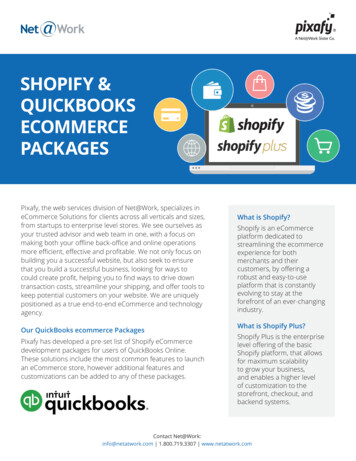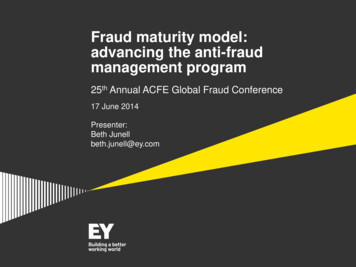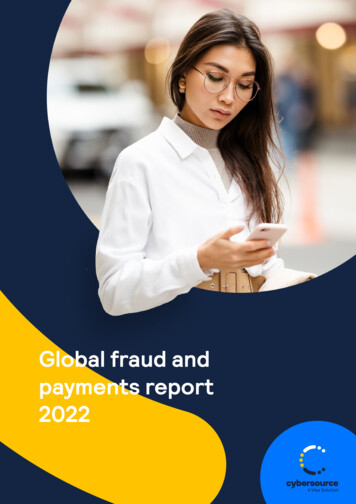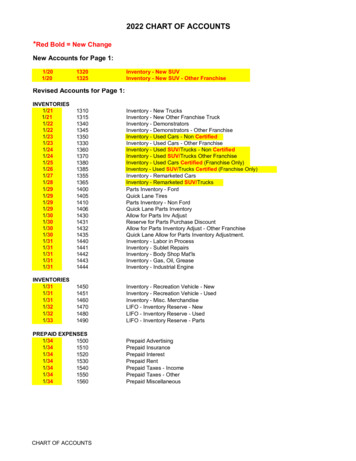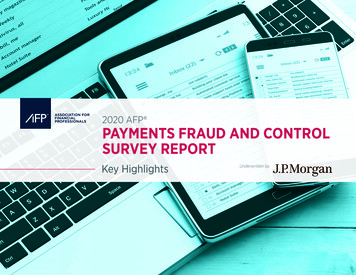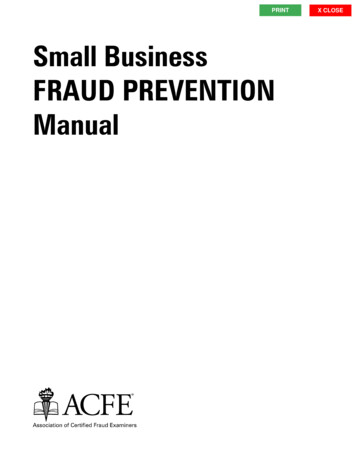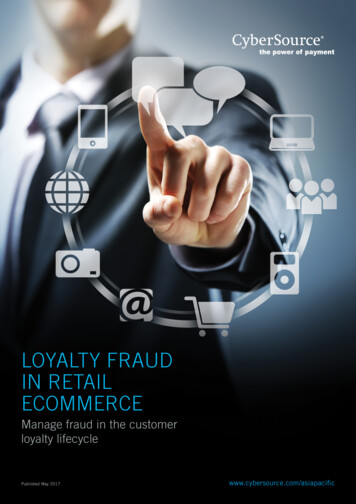
Transcription
LOYALTY FRAUDIN RETAILECOMMERCEManage fraud in the customerloyalty lifecyclePublished May 2017www.cybersource.com/asiapacific
2Loyalty Fraud in Retail eCommerceINTRODUCTIONOnline retail merchants use loyalty or rewards programmes with the aim toprovide a more pleasant and thoughtful shopping experience that is closelyassociated with their brand, and turn customers into faithful followers andregular buyers.Deploying digital rewards is a viable option thanks to the lower cost,convenience, and higher perceived value. However, as with anything of valueand mobility, digital rewards have become a keen target for fraudsters. Giventhat loyalty members contribute the bulk of a merchant’s sales, loyalty frauddetection and prevention is essential to protecting the bottom line.This CyberSource whitepaper will help merchants understand the keyconsiderations, and the appropriate mitigation techniques and tools whenimplementing a loyalty fraud management strategy. Of course, this strategyshould be aligned vis-à-vis the merchant’s overall fraud managementstrategy across various payment channels and customer touch points.Andrea TanAndrea TanDirector, Business Solutions & Segments,CyberSource Asia Pacific
Loyalty Fraud in Retail eCommerceLoyalty Rewards TemptCustomers and FraudstersReward points or dollars may not be real money, but they function just like currency, carryingmonetary value such as gift redemptions, discounts, rebates or cashback vouchers.The monetary value is meant to draw customers into becoming loyal spenders, though it isequally enticing to fraudsters who exploit this channel to steal loyalty data and points, usuallyby exploiting account loopholes, hacking data sources or gaming the programme.Individuals or groups who commit loyalty fraud are not always necessarily organised criminalsor computer hackers. Perpetrators could also be employees who manipulate the points frominside the system, or loyalty members who attempt to cheat the programme to get points,discounts, or redemptions without fulfilling the qualifications.Despite the risks, loyalty programmes are proven to boost sales, customer satisfaction andbusiness reputation. According to Nielsen, 72% of consumers globally—and even more inAsia Pacific (78%)—say they will choose to buy from a retailer with a loyalty programme overone without1. Another survey done by Forrester found that the average loyalty membershiprate is about nine programmes2 per person.The prevalence of loyalty programmes is set to keep rising, as brands seek to create orstrengthen customer communities, especially during times of challenging economic conditionsand fickle consumer sentiment.So, as digital loyalty programmes evolve from a routine marketing tactic to a strategiccompetitive differentiator, merchants will invest in new or enhanced programmes, which inturn increases the value of loyalty currency to customers. This, however, inevitably heightensthe risks of loyalty fraud as well.1Nielsen, “Allegiant Alignment: What Faithful Followers of Retail Loyalty Programs Want.” Nov 2016. l-loyalty-programs-want.html2Forrester, “North American Consumer Technographics Customer Lifecycle Survey 2”, Q3 2014.3
4Loyalty Fraud in Retail eCommerceLOYALTY FRAUD:A Different Challenge From Payment FraudIt is important merchants understand that loyalty fraud is not managed the same wayas payment fraud. That is because payment fraud strikes mainly at the checkout stage,whereas loyalty fraud infiltrates the customer’s buying journey much more fluidly.This type of fraud can creep in at any one or more areas along the entire customer loyaltyjourney—at account creation or access before a purchase, during payment at checkout, or atpost-purchase redemption—which gives fraudsters more avenues and opportunity. Here are afew scenarios: Fraudster creates a fake loyalty account and takes over a genuine customer’s loyalty account,transferring all the points to the fake account. The goal may either be to redeem a lot of freemerchandise or sell the points for cash. Fraudster hacks a customer’s shopping account and deliberately makes big, expensive orders fordelivery to that victim’s shipping address. That’s because the intention all along was to steal theearned loyalty points before either victim or merchant realises the con. Fraudster takes over a loyalty customer’s account to get access to other valuable personaldata such as email, phone number, address, password, and payment details. Armed with thisdata, the fraudster can hack other accounts belonging to the same customer, steal paymentcredentials, and run identity scams—all while milking the fact that between 31% and 55% ofpeople use the same password at multiple sites3.Merchants would never ignore or downplay payment fraud in running their business. In the samevein, they should not dismiss loyalty fraud. Furthermore, loyalty accounts are a tempting alternativein the eyes of fraudsters. This is because loyalty accounts are, to some extent, easier to targetcompared to online payment channels, due to the following reasons:3 Unlike bank or credit card accounts, customers may not check their loyalty accounts as often,especially if they have too many to remember. What’s left is a vault of unredeemed points in oftendormant accounts. Merchants may deploy fewer or no controls to mitigate loyalty fraud, unlike online payment fraudwith which they are more familiar and tend to invest most of their budget and resources. Rewards currency at present is not well-covered by financial regulations with comprehensive andcohesive liability protection—something fraudsters will readily exploit at the merchant’s expense.Center for Internet Security, “Reusing Passwords on Multiple Sites”, Jun 14, 2016. ultiple-sites
Loyalty Fraud in Retail eCommerce5THE HIGH COSTSof Loyalty FraudLOSS OF REVENUEThe financial implications of loyalty fraud attacks cannot be underestimated. Loyalty currencycontains value to redeem products or services of value, and exist as liabilities on themerchant’s balance sheet. Hence, any fraudulent use of the points would mean a write-off onthe balance sheet, which in turn impacts margins.As an example, reward redemptions typically require a minimum or tiered amount of pointswith the purpose of encouraging shoppers to spend more to meet the criteria. If the loyaltypoints used in redemption were stolen or purchased illegally, then the exchanged monetaryitems—whether it is merchandise, rebates or cash vouchers—will be counted as losses in themerchant’s revenue books. If reward points were awarded to purchases made with fraudulentcards, the merchant is hit twice with chargeback losses.LOSS OF CUSTOMER TRUST AND REPUTATIONResearch from Forrester found that one in four shoppers aged between 18 years and 34years are willing to share their personal data to get exclusive discounts4. Merchants, on theirend, want personal data to understand their best customers in the loyalty database better.Foremost in this exchange of personal information between the two parties is trust.Theft or illegal use of loyalty account points is often linked to a massive data breach ofsensitive user information. When that happens, it is not just customer trust that gets eroded,but merchant reputation and brand value as well.The experience of having both their loyalty account points and personal data being stolen candeter even the most longstanding loyal shoppers from ever returning. This results in a massiveloss of customer lifetime value, since loyalty members makeup a large proportion of sales. And if aggrieved customerstake to social media to air their views, the increasedbad publicity will aggravate the negative sales andreputational impact on the merchant.4Forrester, “North American Consumer Technographics Customer Lifecycle Survey 2”, Q3 2014.
6Loyalty Fraud in Retail eCommerceHOW TO MITIGATELoyalty FraudMANAGEMENT THROUGHOUT THE CUSTOMER LIFECYCLELoyalty programmes are designed to nurture customer relationships, so they are neverconfined to a single, isolated activity. This ongoing customer engagement forms a journeyotherwise known as the customer loyalty lifecycle.Defending the entire loyalty chain is imperative because fraudsters will keep lookingfor loopholes and vulnerabilities to exploit at one or more stages along the lifecycle. Forexample, they might use multiple different devices in an attempt to log in to an accountwithin a short time, make multiple transfers of points into an account, or link otherpersons to a loyalty account via new devices.The CyberSource Loyalty Fraud Management Solution protects a merchant’s revenue andbest customers by accurately detecting and stopping fraudulent behaviours throughout theloyalty lifecycle—from points purchase and account creation to redemption, and all otheractivities in between, such as incremental or sudden points increase.The solution equips merchants with two major capabilities that will strengthen defence andreduce risk in their loyalty programmes:ACCOUNT MONITORINGAccount Takeover Protection is thefirst line of defence by identifyingfraud at account creation and login,while monitoring for suspiciousaccount changes.Consumers use multiple devices tomake purchases and earn points, somerchants need intelligent technologyin scanning behavioural changes todistinguish between valuable returningcustomers and fraudulent accountcreation or account takeover attempts.TRANSACTION SCREENINGDecision Manager screens for fraud atthe point of transaction or checkout,to protect purchase or redemption ofloyalty points.As the world’s largest fraud detectionradar, Decision Manager increasesfraud pattern visibility by 200X, andevaluates hundreds of data elementsto detect fraud accurately with orwithout credit card information sinceloyalty transactions may not involvestandard payment types.
Loyalty Fraud in Retail eCommerceGet additional support from CyberSource Managed Risk ServicesComplement your fraud management tools and capabilities with CyberSource fraud experts orscale your expertise and capacity without adding fixed headcount. Our fraud analysts provideconsultation on fraud prevention configuration, best practices and industry strategies to helpensure that fraud rates are kept low, while operations are kept efficient.Complement your in-house skills and resources with the global team of CyberSource fraudmanagement experts. Managed Risk Analysts, who serve clients on five continents, can helpyou optimise Decision Manager and scale operations. This network of experts can help youidentify new fraud trends before they affect your business.Protect Your Customer Relationships,PROTECT YOUR PROFITSLoyalty programmes are one of the most effective ways merchants can use to increasethe volume of repeat customers and revenue. The loyalty points themselves may not belegal tender; but as loyalty currency they entail monetary benefits that are tied to sales andprofit margins, and hence require adequate, holistic loyalty fraud management. Otherwise,a business risks letting loyalty fraud destroy the very thing the loyalty programme wasdesigned for.With the CyberSource Loyalty Fraud Management Solution, you can growyour loyalty programme to boost customer retention and brand loyaltywithout fear of fraud.7
DISCLAIMERCase studies, statistics, research and recommendations areprovided “AS IS” and intended for informational purposes onlyand should not be relied upon for operational, marketing, legal,technical, tax, financial or other advice. CyberSource is notresponsible for your use of the information contained herein(including errors, omissions, inaccuracy or non-timeliness of anykind) or any assumptions or conclusions you might draw from itsuse. CyberSource makes no warranty, express or implied, andexplicitly disclaims the warranties of merchantability and fitnessfor a particular purpose, any warranty of non-infringement of anythird party’s intellectual property rights.CyberSource, a wholly owned subsidiary of Visa Inc., is the only integrated payment management platform built onsecure Visa infrastructure, with the payment reach and fraud insights of a massive 358Bn global processing network.CyberSource and Authorize.Net payment management solutions help 475,000 large and small businesses grow sales,mitigate risk, and operate with greater agility. CyberSource operates globally, and is headquartered in San Francisco,California and maintains offices throughout the world, with regional headquarters in Singapore, Tokyo, Miami / Sao Pauloand Reading, U.K.For more information, please visit www.cybersource.com/asiapacificASIA PACIFICLATIN AMERICA & CARIBBEANNORTH AMERICA (US & Canada)Asia Pacific CYBS Singapore Pte LtdPhone: 01-800-6671-5000 (Singapore / Thailand)Phone: 00-800-6671-5000 (Malaysia)Phone: 000-800-630-1003 (India)Phone: 1-800-8-756-8388 (Philippines – Globe)Phone: 1-800-10-802-7222 (Philippines – PLDT)Email: ap enquiries@cybersource.comWebsite: www.cybersource.com/asiapacificCyberSource MiamiEmail: lac@cybersource.comWebsite: www.cybersource.com/lacCyberSource Corporation HQEmail: sales@cybersource.comWebsite: www.cybersource.comCyberSource MexicoEmail: mexico@cybersource.comWebsite: www.cybersource.com.mxEMEA (Europe, Middle East & Africa)CyberSource Australia & New ZealandPhone: 0011-800-6671-5000 (Australia)Phone: 00-800-6671-5000 (New Zealand)Email: anz enquiries@cybersource.comWebsite: www.cybersource.com.auCyberSource BrazilEmail: brasil@cybersource.comWebsite: www.cybersource.com/brasilCyberSource EMEAEmail: uk@cybersource.comWebsite: www.cybersource.com/emeaCyberSource Visa Middle East FZ-LLCWebsite: www.cybersource.com/meaCYBS Greater ChinaEmail: gc enquiries@cybersource.comWebsite: www.cybersource.com/cnCyberSource KK (Japan)Phone: 81 3 3548 9873Email: sales@cybersource.co.jpWebsite: ic由CyberSource Corporation或CyberSource International, Inc. 提供的服务Services provided by CyberSource Corporation or CyberSource International, Inc. 2017 CyberSource Corporation, a Visa company. All rights reserved.LFRWP/201703
persons to a loyalty account via new devices. The CyberSource Loyalty Fraud Management Solution protects a merchant's revenue and best customers by accurately detecting and stopping fraudulent behaviours throughout the loyalty lifecycle—from points purchase and account creation to redemption, and all other
